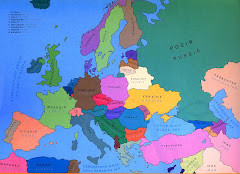 Painting by Elena Flyat (елена флят), a modern rendition of ancient techniques, images and symbols of Arts Slobodskoy. Elena is a master of the tradition.
Painting by Elena Flyat (елена флят), a modern rendition of ancient techniques, images and symbols of Arts Slobodskoy. Elena is a master of the tradition. Vera and I just finished a grant application to the U.S. Ambassador's Cultural Preservation Fund for the project "Ancient Decorative Paintings of the Slobodskoy Region" (now Lugansk Oblast). It was a huge challenge, translating Vera's Ukrainian into English and refining and revising the narrative for clarity. Natalia Dohadailo, English teacher extraordinaire at the university, helped. A few late nights helped, too. But it's all worth it. The purpose of the project is the collection, preservation and promotion of an indigenous folk art tradition. I love the project because cultural preservation is desparately needed in eastern Ukraine, and folk art painting is in danger of extinction.
Much of the cultural heritage of Ukraine was suppressed, denied and almost obliterated under Soviet rule, more so in the East than in the West. Artists, poets, writers, craftsmen, East and West, were imprisoned for what was called "nationalist tendencies," meaning a devotion to Ukrainian tradition rather than exclusive allegiance to the Soviet regime. Local poet Ivan Savich, for example, was sent to the Gulag for 8 years. His crime: writing in the Ukrainian language, focusing on Ukrainian themes and traditions, showing a love of Ukrainian culture.
Yet these indigenous, unique artistic traditions and crafts, in this case specifically the antique paintings of old masters on precious and everyday items, from wedding chests to household items, tell us much about Ukrainian heritage and history. The folk art embodies amazing stories and symbols that need to be collected, preserved and shared.They need to become part of a national Ukrainian heritage.
I have seen some of the items painted by old masters using ancient techniques and unique patterns, and they are beautiful. They reveal the talent and daily life of ancestors who called this region home. They have much to share with the present.
Master painter and creative artist Elena Flyat, with the help of NGO VIctoria, is devoting her time, hard work and creative energy to keeping this tradition alive. Elena paints in the tradition, updating but adhering to the techniques of the old paintings and the symbols embedded in them. I have given some of Elena's paintings as presents to my family, bringing a bit of Ukraine back home.
Why is preserving the ancient folk art painting of eastern Ukraine so important? Because I believe, with Elena and Vera, that these kinds of projects contribute to the ongoing transformation of Ukraine into a proud modern nation built on the foundations of an incredible indigenous culture.
Such projects are needed now, more than ever, as Ukraine struggles to find its identity and embrace the future. Here is some narrative from our grant application explaining the importance and value of Arts Slobodskoy, and presenting some interesting history of Starobelsk and Lugansk.
This project aims to promote the revival and preservation of ancient decorative painting and increase interest in indigenous folk art traditions in the Starobelsk area and Luhansk region. It will also uncover and promote the creative ability of local artists. Preserving cultural treasures is a critical aspect of creating a unified democratic Ukraine bound by ties of culture and tradition. Unfortunately, preservation and promotion of cultural heritage is not a priority, especially in Eastern Ukraine, where it is most needed.
Our city has an interesting past and historical roots of popular and applied art, although it is largely unknown and unhearalded. Starobelsk is the ancient merchant town and cultural and commercial center of the region. Every year since 1824 the city has held four large folklife fairs. Touring merchants from Moscow, Tula, Voronizhu, Kharkiv, and Poltava traded goods to buy local grain, honey, flour, and butter. There was also a great demand for folk art painted by the old masters: pottery, chests, furniture, and goods for household consumption.
Our city has an interesting past and historical roots of popular and applied art, although it is largely unknown and unhearalded. Starobelsk is the ancient merchant town and cultural and commercial center of the region. Every year since 1824 the city has held four large folklife fairs. Touring merchants from Moscow, Tula, Voronizhu, Kharkiv, and Poltava traded goods to buy local grain, honey, flour, and butter. There was also a great demand for folk art painted by the old masters: pottery, chests, furniture, and goods for household consumption.
In today's Starobelsk there are 20,000 inhabitants and in the region 50,000 thousand, but there are no more masters who created and fully owned the ancient technique of painting. Products of these artists have made the Slobodskoy region special and attractive. In remote villages you can still find ancient painted chests, cabinets, tables, utensils, and household consumer goods in the homes of distant relatives of the old masters, the remaining particles of ancient skills and knowledge of ancient technology. They can also be found in slum dwellings of Lugansk towns and cities, hidden in old houses mostly by chance, a discarded chest here, a bowl there.
These rare and hard-to-find items are fast disappearing; they require research, diligent searching, analyzing for authenticity, documenting and recording. Lack of interest and funding from local authorities for the revival and preservation of our cultural heritage will lead to the final disappearance of this unique tradition. These painted items, precious treasures of our shared past, need to be recovered now, or they will be lost forever.




























No comments:
Post a Comment